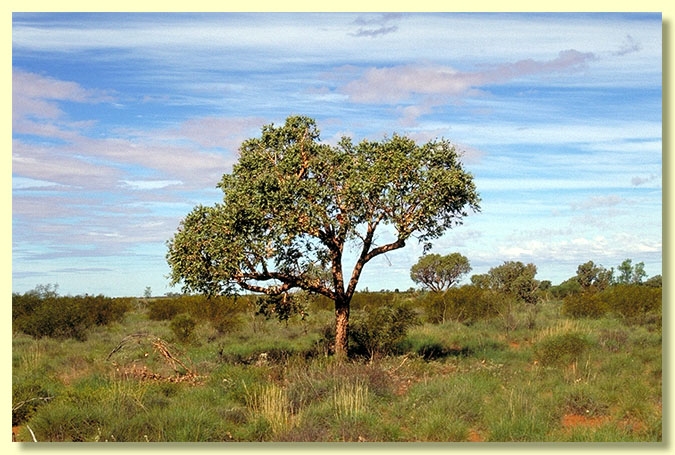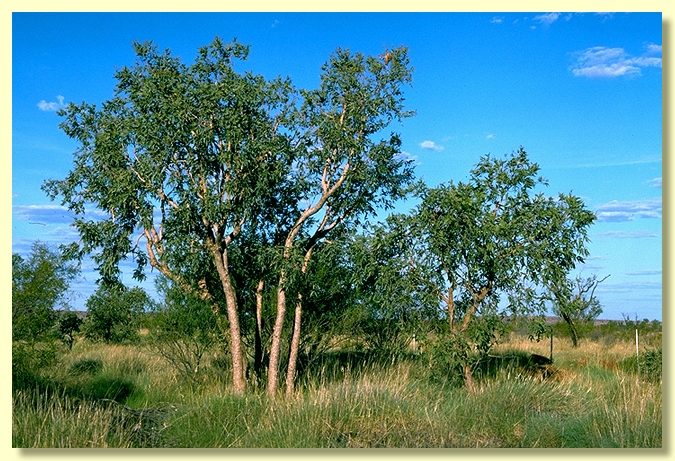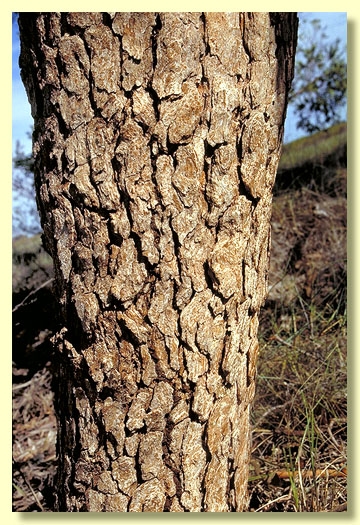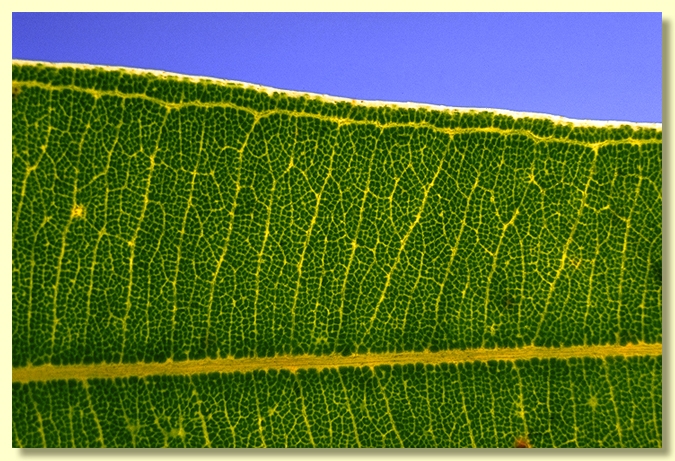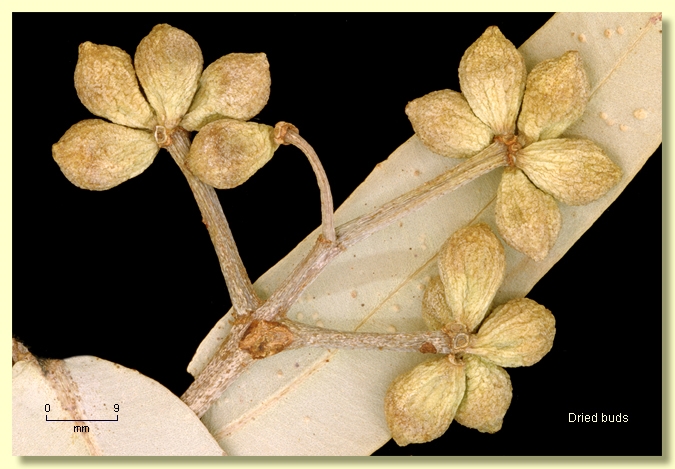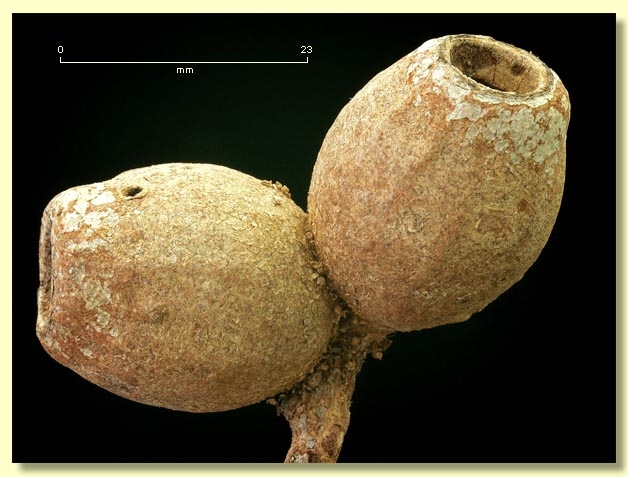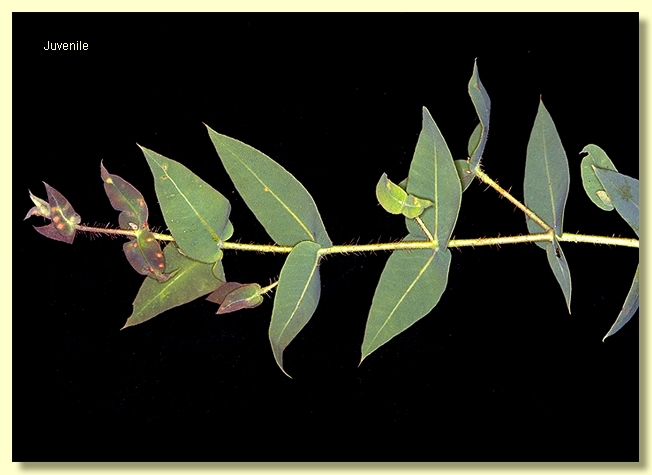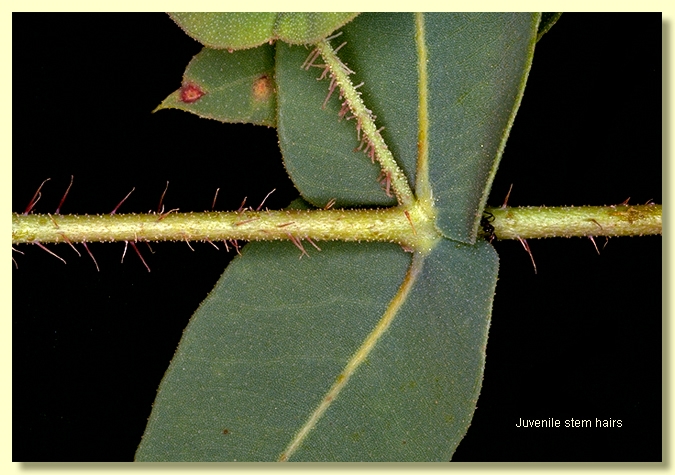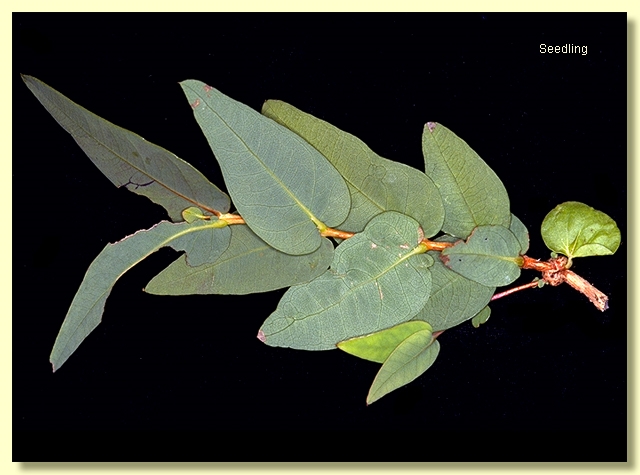Euclid - Online edition
Corymbia zygophylla
Corymbia | Rufaria
Corymbia zygophylla (Blakely) K.D.Hill & L.A.S.Johnson, Telopea 6: 349 (1995).
Eucalyptus zygophylla Blakely, Key Eucalypts 88 (1934). T: Broome, Western Australia, Apr. 1905 & June 1906, W.V.Fitzgerald s.n.; lecto: NSW, fide K.D.Hill & L.A.S.Johnson (ibid.). Chippendale, Fl. Austral. 19: 76 (1988), in addition cites “isolecto: PERTH” but this is not mentioned in Hill & Johnson’s more recent publication, nor have we viewed this specimen. The original collection was apparently a mixture of E. zygophylla and E. setosa. The reader is referred to the above two publications and also to Blake, Austral. J. Bot. 1: 262 (1953), for further details.
Tree or mallee to 6 m tall. Forming a lignotuber.
Bark rough to the small branches, tessellated to fibrous, pale grey-brown over slightly darker brown.
Branchlets lack oil glands in the pith; slightly scabrid or smooth.
Juvenile growth (coppice or field seedlings to 50 cm): stems rounded in cross-section, hairy (setose); juvenile leaves sessile and amplexicaul, opposite, cordate, 3.5–10 cm long, 1.5–4.5 cm wide, concolorous, grey-green; lower leaves scabrid on both surfaces, prominently setose on midrib on underside only; upper leaves lack prominent setae but may still feel scabrid or be smooth.
Crown leaves juvenile, opposite, sessile; blade cordate to lanceolate, 6.5–14.5 cm long, 1.8–6 cm wide, base amplexicaul, margin entire, apex pointed, concolorous, dull, green, smooth or slightly sandpapery (scabrid), side-veins at greater than 45° to midrib, reticulation very dense, intramarginal vein present, oil glands apparently absent.
Inflorescence terminal compound, peduncles stout, 0.7–2.3 cm long, buds 3 or 7 per umbel, sessile or shortly pedicellate (pedicels 0–0.3 cm long). Mature buds more or less ovoid, 1–1.3 cm long, 0.7–0.8 cm wide, the surface ± smooth or slightly roughened with a few short bristle-glands, scar absent (both opercula shed together at flowering), operculum broadly conical to rounded and apiculate, rarely beaked, stamens inflexed, all fertile, anthers versatile, dorsifixed, oblong, dehiscing by longitudinal slits, style long and straight, stigma mop-like, locules 4, the placentae each with ca 7 vertical ovule rows or the rows indistinct. Flowers white.
Fruit sessile or very shortly pedicellate (pedicels 0–0.3(0.5) cm long), urceolate to truncate-globose, 1.8–3.5 cm long, 1.7–3.3 cm wide, surface slightly scurfy or smooth (not bristly), disc descending obliquely to almost vertically, valves 4, enclosed.
Seeds brown, 10–14 mm long, ellipsoidal with terminal wing, hilum ± ventral.
Cultivated seedlings (measured at ca node 10): cotyledons large, reniform; stems rounded in cross-section, setose with bristle-glands until internode ca 9 or 10 then glabrous; leaves sessile and opposite throughout, cordate to lanceolate, 2.5–10.5 cm long, 0.8–4.2 cm wide, base amplexicaul, dull, pale green or slightly grey-green, scabrid becoming ± glabrous (smooth) after 7–10 pairs.
Flowering time unrecorded but reputed to be summer.
A mallee or small tree endemic to Western Australia, occurring in the southern Kimberley region from near Fitzroy Crossing to Derby and Broome and the Edgar Range, and sporadically in the Pilbara region on the coastal plain from near Port Hedland to Onslow, Giralia and in the North West Cape area, with an outlier to the east at Anketell Hills in the Great Sandy Desert. Prefers open plains and sandhills. Corymbia zygophylla is fully rough-barked and has a crown of opposite sessile lanceolate leaves that are smooth to slightly rough, more or less sessile buds that are smooth or slightly rough but not scurfy and have a rounded to conical operculum, and more or less urceolate, sessile fruit 1.7–3.3 cm wide.
In the region where C. zygophylla occurs there are several species of bloodwood with rough bark and a crown of opposite leaves. The Kimberley species C. cadophora differs from C. zygophylla in having the sessile crown leaves occurring in basally connate pairs, and, further south, C. deserticola subsp. deserticola has smaller crown leaves to 6.2 cm long, and smaller fruit (0.9–1.6 cm wide). C. pachycarpa, a species from the northern fringes of the Great Sandy and Tanami Deserts, differs in having prominently setose buds with beaked operculum.
Plants in the coastal area of the Pilbara region are more likely to have slightly sandpapery crown leaves and conspicuously setose juvenile (coppice) growth than is encountered in Kimberley plants, but smooth-leaved crowns are more common state in both areas.
In the classification of Brooker (2000) Eucalyptus zygophylla is placed in Eucalyptus subgenus Corymbia (the bloodwoods). In their revision of the bloodwoods and ghost gums, Hill & Johnson (1995) named this species Corymbia zygophylla, i.e. genus Corymbia section Rufaria (the bloodwoods).
The inner operculum of the buds of Corymbia zygophylla is sometimes partially divided into petals. This can only be seen with careful dissection of the buds.
MORE ABOUT CORYMBIA
MORE ABOUT RED BLOODWOODS
Corymbia zygophylla: Greek zygon, yoked, occurring as a pair and phyllon, a leaf, referring to the opposite pairs of leaves found in the crown.

